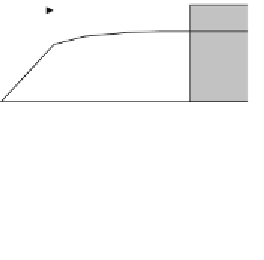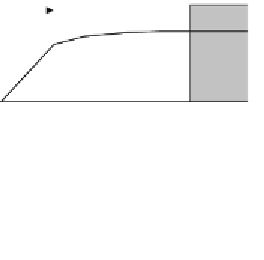Geoscience Reference
In-Depth Information
The following formula for this internal set-up
S
is suggested
For small amplitudes
(H << D) S/H =
;
F/
2
(16.29a)
F
)
0.5
- 1
For large amplitudes
(H ~ D) S/H =
(1+
;
(16.29b)
Note, that
S
represents the average water table inside the breakwater, upon
which the cyclic part has to be superimposed. Here,
D
is the still water depth,
H
the
wave amplitude,
S
the set-up,
=
c
a
H
2
/(2
),
c
a
the air-intrusion factor
59
,
;
2
D
tan
the slope angle,
)),
k
the
permeability,
T
the wave amplitude and
n
the porosity. The factor
F
depends on the
width of the structure
L
and the inner boundary condition (open or closed), see Fig
16.13.
2
the cyclic penetration length (
2
=
(
kDT
/
n
T
T
S
S
H
H
D
D
x
x
L
L
T
T
S
S
H
H
D
D
x
x
L
L
Figure 16.13 Internal set-up for closed end (F
1
), open end (F
2
) and S
max
at L or x
2
Dynamic slope stability
Cyclic wave induced effects on the slope stability cause a variation in the
stability factor, related to the variation of the free water level. Two typical
situations, i.e. at the moment of a wave top at the slope and of a wave trough at the
slope, are shown in Fig 16.14. In both situations the inner water table (B) follows
the outer one (A) with a retardation. The actual porous flow fields and the
corresponding critical cyclic slip surfaces reveal that the dynamic stability factor
F
d
is lowest, just before the wave trough, because then pore water is flowing out of the
slope.
A sensitivity analysis, varying the characteristic parameters, such as wave
height, slope angle, internal friction angle and average water depth over a wide
range, results in
F
d min
/F
s
0.1 (
F
s
is the static stability factor), allowing a
general statement, that significant dynamic wave effects decrease the static slope
stability with 20% to 30%.
0.8
4
59
Air intrusion is entrapped air during inflow, for waves on coarse structures
c
a
may reach
up to 4; for tides
c
a
= 1.














































































Search WWH ::

Custom Search